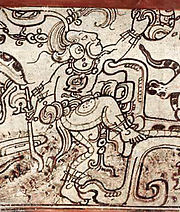Chaac

Chaac (also spelled Chac or, in
Rain deities and rain makers

Like other Maya gods, Chaac is both one and manifold. Four Chaacs are based in the cardinal directions and wear the directional colors. East, where the sunrise is, is red, North, mid-day zenith, is represented by white, West is represented by black for the sunset, and South is represented by yellow. There is a fifth color which is associate with the center point, and that is green.[1] In 16th-century Yucatán, the directional Chaac of the east was called Chac Xib Chaac 'Red Man Chaac', only the colors being varied for the three other ones.[2]
Contemporary Yucatec Maya farmers distinguish many more aspects of the rainfall and the clouds and personify them as different, hierarchically-ordered rain deities. The Chorti Maya have preserved important folklore regarding the process of rain-making, which involved rain deities striking rain-carrying snakes with their axes.
The rain deities had their human counterparts. In the traditional Maya (and Mesoamerican) community, one of the most important functions was that of rainmaker, which presupposed an intimate acquaintance with (and thus, initiation by) the rain deities, and a knowledge of their places and movements.[3] According to a Late-Postclassic Yucatec tradition, Chac Xib Chaac (the rain deity of the east) was the title of a king of Chichen Itza,[4] and similar titles were bestowed upon Classic rulers as well (see below).
Rain rituals
Among the rituals for the rain deities, the Yucatec Chʼa Cháak ceremony for asking rain centers on a ceremonial banquet for the rain deities. It includes four boys (one for each cardinal point) acting and chanting as frogs. Asking for rain and crops was also the purpose of 16th-century rituals at the cenotes, of Yucatán. [citation needed]
Mythology

The rain deity is a patron of agriculture. A well-known myth in which the Chaacs (or related Rain and Lightning deities) have an important role to play is about the opening of the mountain in which the maize was hidden. In
In some mythologies, it is believed that water and clouds are formed within the Earth in caves and cenotes and then carried into the sky by deities such as Chaac.[6] Classic period Maya sources also suggest that Chaac was the god who opened the mountain containing maize, using his lightning axe, K'awil. [7]
Iconography

Chaac is usually depicted with a human body showing reptilian or amphibian scales, and with a non-human head evincing fangs and a long, pendulous nose. In the Classic style, a shell serves as his ear ornament. He often carries a shield and a lightning axe, the axe being personified by a closely related deity,
Rain
A large part of one of the four surviving Maya codices, the
Warfare
In the Classic period, the king often impersonated the rain deity (or an associated rain serpent) while a portrait glyph of the rain deity can accompany the king's other names. This may have given expression to his role as a supreme rain-maker. Typically, however, it is the war-like fury of the rain deity that receives emphasis (as is also the case in the myth mentioned above). The king personifying the rain deity is then shown carrying war implements and making prisoners,[9] while his actions seem to be equated with the violence of a thunderstorm.
Classic period narrative
About Chaahk's role in Classic period mythological narrative, little is known. He is present at the resurrection of the
In popular culture
- Chaac is featured in Marvel Comics as part of the Ahau (a pantheon of gods worshipped by the Maya people).[11]
- In the 1984 movie The Mutilator, a mask that is said to be of Chaac is shown and discussed.
- In Talokan, whose ancestors found themselves dying due to smallpox introduced by Spanish colonizers, and prayed to him for a cure that gave them blue skin and gills that restricted their ability to breathe air on the surface, thus forcing them to settle underwater and establish Talokan as a new civilization.
- Chaac is a playable warrior in SMITE.
See also
- Klein, Rolando (Director), Chac: Dios de la lluvia (1975), a film made with Maya actors.
- Yopaat, a closely related southern Maya storm god
- Aktzin
References
Citations
- ^ Hopkins, Nicholas. "Directions and Partitions in Maya World View" (PDF).
- ^ Landa, in Tozzer 1941: 137–138
- ^ Braakhuis and Hull 2014
- ^ Roys 1967: 67–68
- ^ Thompson 1970: 364
- ^ Vail, Gabrielle; Hernández, Christine (2013). Re-Creating Primordial Time: Foundation Rituals and Mythology in the Postclassic Maya Codices. University Press of Colorado. pp. 63–64.
- ^ Vail, Hernandez 2013: 66
- ^ "O Códice de Dresden". World Digital Library. 1200–1250. Retrieved 2013-08-21.
- ^ García Barrios 2009
- ^ García Barrios 2009: 18-21
- ^ Thor & Hercules: Encyclopaedia Mythologica #1. Marvel Comics
Sources
- Braakhuis, Edwin, and Kerry Hull, Pluvial Aspects of the Mesoamerican Culture Hero. Anthropos 2014/2: 449–466.
- Cruz Torres, Mario, Rubelpec.
- García Barrios, Ana, El aspecto bélico de Chaahk, el dios de la lluvia, en el Periodo Clásico maya. Revista Española de Antropología Americana 39-1 (2009): 7-29.
- Redfield, Robert, and Alfonso Barrera Vasquez, Chan Kom.
- Roys, Ralph L., The Book of Chilam Balam of Chumayel. 1967.
- Taube, Karl, An Illustrated Dictionary of the Gods and Symbols of Ancient Mexico and the Maya.
- Thompson, J.E.S., Maya History and Religion. 1970.
- Tozzer, Alfred, Landa's Relación de las Cosas de Yucatán, a Translation. 1941.
- Wisdom, Charles, The Chorti Mayas.

